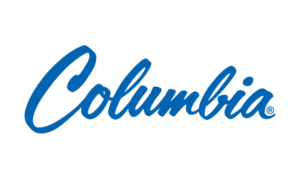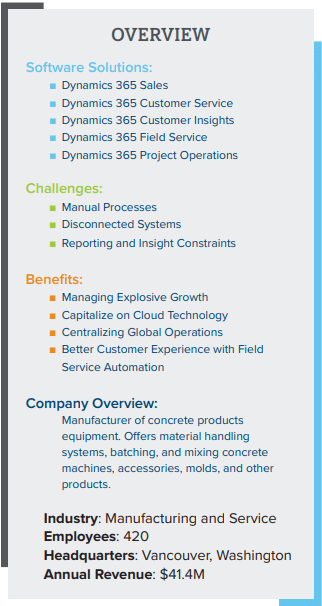Revolutionizing Client Engagement: Columbia Machine’s Journey from Outdated CRM to Cutting-Edge Solutions
Learn how Velosio helped Columbia Machine replace their outdated CRM Microsoft Dynamics Customer Engagement.
Table of Content
Founded in 1937 in Vancouver, Washington, Columbia Machine, Inc., is a worldwide leader in the design, manufacturing, and support of equipment for a variety of industries. Primary business units include Batching and Mixing Solutions, Concrete Products Equipment Solutions, Production Equipment Molds, Mechanical Palletizing Machines and Robotic Palletizing Solutions. Columbia Machine is one of the world’s leading manufacturers of concrete products equipment, serving customers in over 100 countries. From mixing and batching to automatic cubing and splitting, Columbia builds a complete line of equipment to outfit an entire concrete products plant.
design, manufacturing, and support of equipment for a variety of industries. Primary business units include Batching and Mixing Solutions, Concrete Products Equipment Solutions, Production Equipment Molds, Mechanical Palletizing Machines and Robotic Palletizing Solutions. Columbia Machine is one of the world’s leading manufacturers of concrete products equipment, serving customers in over 100 countries. From mixing and batching to automatic cubing and splitting, Columbia builds a complete line of equipment to outfit an entire concrete products plant.

In the past, Columbia Machine used Sugar CRM to manage customer service and field service but ran into limitations when attempting to expand its use of the solutions. Columbia had tried Salesforce in the past, but it was too expensive. They knew they needed to upgrade their solution prior to Sugar’s upcoming annual renewal in less than eight months. With Microsoft Dynamics 365 Business Central, Sales, Marketing, and Customer Service in place, they decided to transform the company into a complete Microsoft shop by adding Microsoft Dynamics 365 Field Service. This would give them an end-to-end solution that ties together all departments, so everyone has 360 visibility to every client from marketing through sales, delivery and finance.
Goals included managing their explosive growth trajectory, managing field service for recently acquired companies with multi-language and multi-company, and field service scheduling for technicians servicing and installing huge, custom-built machines which sometimes have a 30+ year lifetime. The ultimate goal was to bring global operations under one roof. With Sugar, the team was managing field service, but it was difficult to report on activities, phone calls, and tasks at the customer level, or efficiently track warranty information. There was not an accurate timeline, and reporting was inadequate.
“We started way back when with a homegrown solution, then Salesforce, then Sugar, and we didn’t have too many challenges with any of them, but the goal was to become a full Microsoft shop with an end-to-end Microsoft solution,” says Nikki Hagen, business analyst for CRM and ERP at Columbia. “Although it had limitations, we could have continued using Sugar, but we wanted to roll out the solution to our international subsidiaries and Dynamics is a more stable solution internationally,” adds Richard Armstrong, project manager for Columbia.
“Any questions we had, they had very quick answers— coming up with solutions to any of our pain points or challenges very quickly. The Velosio team continues to be great.”
– Nikki Hagen
Business Analyst for CRM and ERP, Columbia
Because of a tight timeline to beat the Sugar renewal, the Columbia team documented everything that they wished for in the new system so that the project would flow much smoother. Every detail was laid out for Velosio’s implementation team so that no questions were left unanswered. Velosio implemented Columbia’s wish list without custom code, instead tackling the job within Power Apps for smoother future upgrades. Phase I involved transitioning the data from Sugar to Dynamics 365 Field Service without a lot of changes to the current processes. The project was completed on time within seven months and within budget to beat the Sugar renewal date.
Nikki and Richard spent a lot of time training with their implementation team so that they could disseminate the information to the end users. “After we were trained, we then held separate meetings with the sales team and services team on Teams with screen sharing,” describes Hagen. The Columbia team saved recordings from those meetings on their Teams channel so that people could refer to them. “My next step is to create short three-to-five-minute videos on topics like how to create a lead or convert a lead into a prospect or entering a support case so that when new employees come on, they can watch those short videos to learn,” continues Hagen.
In Sugar, Columbia manually entered service scheduling outside the system for double entry, creating errors and omissions. Dynamics 365 Field Service was implemented to streamline scheduling and eliminate double entry. The team can now perform all functions within the system. “The information in Dynamics is readily available and easy to find,” says Hagen. “Data organization, and the way the forms are laid out, as well as navigation of the product is easier. It’s intuitive how the tables are related to each other— and the functionality of building views across multiple tables at once is a huge benefit. I like how information searches are customized for the user base – this is great. And using different apps for each department to narrow the scope of what they can see is wonderful,” continues Hagen. “The mobile aspects of Dynamics are stronger,” says Armstrong. “The reporting within field service is more powerful. Sugar had strange limitations that are not a problem with D365. It’s intuitive. And it’s Microsoft so it’s more accepted by the users,” continues Armstrong.
Columbia Machine can now:
“I can’t say enough about the professionalism and knowledge of Stu, Heather, and the rest of the Velosio team,” says Hagen. “They worked tirelessly to hit our target for go-live. Their knowledge was incredible. I would definitely work with them again,” adds Hagen. “The professionalism, knowledge, and sense of urgency from the Velosio team was brilliant,” says Armstrong. “Even if it was a Friday night or weekend they were jumping on any problem. It’s deeply appreciated and noted by our team,” concludes Armstrong.
Talk to us about how Velosio can help you realize business value faster with end-to-end solutions and cloud services.
"*" indicates required fields